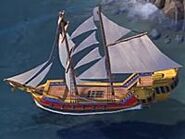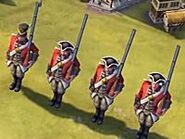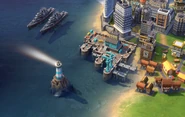No edit summary |
No edit summary |
||
| Line 5: | Line 5: | ||
|leader = Victoria |
|leader = Victoria |
||
|ability-name = British Museum |
|ability-name = British Museum |
||
| − | |ability-description = Each {{Link6|Archaeological Museum}} can hold six {{Artifact6}} Artifacts instead of three and can |
+ | |ability-description = Each {{Link6|Archaeological Museum}} can hold six {{Artifact6}} Artifacts instead of three and can build two {{Link6|Archaeologist}}s instead of one. Archaeological Museums are automatically themed when they have six {{Artifact6}} Artifacts. |
|leader-bonus-name = Pax Britannica |
|leader-bonus-name = Pax Britannica |
||
|leader-bonus-description = Founding or conquering a [[City (Civ6)|city]] on a {{Link6|continent}} other than your home continent grants a free melee unit in that city. Gain the {{Link6|Redcoat}} unique unit when the {{Link6|Military Science}} technology is researched. |
|leader-bonus-description = Founding or conquering a [[City (Civ6)|city]] on a {{Link6|continent}} other than your home continent grants a free melee unit in that city. Gain the {{Link6|Redcoat}} unique unit when the {{Link6|Military Science}} technology is researched. |
||
Revision as of 08:03, 20 April 2018
The English people represent a civilization in Civilization VI. Their colors are maroon and white, and they are led by Victoria.
The English civilization ability is "British Museum," which provides additional ![]() Artifact slots and Archaeologists in Archaeological Museums. Their unique unit is the Sea Dog (which replaces the Privateer), and their unique district is the Royal Navy Dockyard (which replaces the Harbor).
Artifact slots and Archaeologists in Archaeological Museums. Their unique unit is the Sea Dog (which replaces the Privateer), and their unique district is the Royal Navy Dockyard (which replaces the Harbor).
Strategy
Make your navy a priority. Research Celestial Navigation and Shipbuilding as soon as you can. While you research these techs, make a couple of Galleys to explore and find new continents. Once you research Shipbuilding make several Settlers, send them across the sea to continents, and build Royal Navy Dockyards in your new cities.
After you finish Shipbuilding, you can do one of two things. You can either rush Cartography and Square Rigging to get powerful naval units, or focus on ![]() Science and rush Redcoats (which Victoria's leader ability will provide). The instant you get Redcoats, it's basically over for every other civ. Since they are so expensive to maintain, however, you need to have enough
Science and rush Redcoats (which Victoria's leader ability will provide). The instant you get Redcoats, it's basically over for every other civ. Since they are so expensive to maintain, however, you need to have enough ![]() Gold to support your army, which will grow larger every time you conquer a city on another continent. Keep your economy strong by building Commercial Hubs and economic buildings in your cities and sending
Gold to support your army, which will grow larger every time you conquer a city on another continent. Keep your economy strong by building Commercial Hubs and economic buildings in your cities and sending ![]() Trade Route Trade Routes to city-states and neighbors with whom you aren't at war.
Trade Route Trade Routes to city-states and neighbors with whom you aren't at war.
With Royal Navy Dockyards on every continent, you'll soon attract Great Admirals who can help you achieve naval supremacy. If you get Gaius Duilius (whose ability forms a Fleet out of any naval unit), save him until you get your first Frigate, then use him on it. An early game Frigate Fleet will absolutely destroy coastal cities. Even better, if you get Santa Cruz, you can use him to form a Frigate Armada and own the ocean!
However, controlling the ocean will do you no good if you can't see what's hidden in the shadows, and other players will become suspicious if they see a Frigate Fleet or Armada near their borders. To solve this problem, discover Mercantilism as quickly as possible and begin producing Sea Dogs, then send them out to certain strategic spots on the map so they can patrol the ocean without being seen. If someone tries to turn the tables on you and launch a surprise assault on your shores, you'll know it's coming and be able to capture their ships with your Sea Dogs while the rest of your navy deals with any embarked units.
Civilopedia entry
Until the Normans put an end to all the foolishness, the “Sceptered Isle” had been invaded by anyone who could row a boat: Celts, Bretons, Angles, Romans, Saxons, Vikings and sundry. The kingdom of Britain can be reliably dated from their arrival during the “Norman Invasion.” Others had tried to unite the squabbling nobility of England before; legendary Arthur had supposedly done so; William the Conqueror (also known to history as “William the Bastard” for assorted reasons) actually accomplished the task. Today, “Great” Britain (having overrun the kingdoms of Scotland and Wales) is one of the leaders of the European Union, world’s economy (ranking sixth), and humanity’s culture, home to about 64 million inhabitants.
Having out-survived the rival claimants to the English throne – the Anglo-Saxon Harold Godwinson and Norwegian Harald Hardrada among them – William of Normandy quickly captured Dover, Canterbury, Kent, Southwark, and the royal treasury at Winchester. The stubborn English earls and clergy caved, and in December 1066 AD William was crowned King of England in Westminster Abbey. He spent the rest of his life consolidating his rule, putting down revolts and beating off Viking raids, as well as trying to hang on to his lands back in Normandy. But by 1135 his royal line petered out, and after a brief spell known as “The Anarchy,” the House of Anjou sat upon the English throne.
With the latest (but certainly not the last) of English civil wars settled by the Treaty of Wallingford of 1153, the four Anjevin kings – including the famous Richard the Lionheart and his brother the infamous John Lackland – were undisputed lords of the land. These men formulated the royal coat of arms, bearing a rampant golden lion, a beast not native to Britain’s cold shores … then added two more just to be sure everyone got the message. So bad was John’s rule in England (he also managed to lose Normandy to France) that he was forced to agree to the Magna Carta Libertatum, essentially a peace treaty between the crown and rebellious barons signed in 1215, and then modified over following years. Heretofore, the kings had ruled by “force and will,” making unilateral and arbitrary decisions; now the basis had been laid for a “government by law” guaranteeing the rights of the people – at least, of the landed gentry; the unfortunate peasants would remain chattel for some centuries yet.
English history isn’t just about the affairs of a few dozen royals and nobles, of course; it’s also about the thousands of little people: the serfs, servants, soldiers, tradesmen, priests, merchants, scribes, barkeeps, goodwives, artists and authors and rest of the common folk. The country became self-sufficient as agri- and aquaculture flourished. Trade thrived, and English goods – especially woolen fabrics and hardwood crafts – were in demand throughout Europe. During the Middle Ages, Britain developed a vibrant culture; the Bayeux Tapestry was woven, Chaucer and Mallory penned great works, soaring Gothic cathedrals and castles were built, and folk tales (such as that about the bandit Robin Hood) took root. These upstart commoners were beginning to feel... entitled.
The Anjevins were followed onto the throne of Britain by the even more self-serving Plantagenets, whose main claim to fame was launching the Hundred Years' War (actually, 116 years, 1337-1453, but who’s counting), a blatant attempt to grab the crown of France to add to their collection. Their term came to an end when the thoroughly unpleasant Richard II was deposed in September 1399 and died (rumored by starvation) a few months later while in captivity. The House of Lancaster took the throne, but in short order their right to rule was challenged by the House of York, also a cadet branch of the Plantagenets. Commencing in 1455, a sporadic conflict – the bloody if colorful Wars of the Roses – raged between the two, marked by much intrigue and changing of sides by the opportunistic barons. In the end, with York and Lancaster having pretty much annihilated each other, Henry Tudor, a relatively undistinguished scion of the Beauforts, having defeated the last Yorkist king, Richard III (who was slain in the battle), at Bosworth Field, became the new King of England.
Henry Tudor, dubbed the VII, promptly married Elizabeth of York to end any rival claims. And set about restoring political and financial stability to the government, mainly through ruthless mechanisms of taxation that stretched the bounds of the law, and then created the King’s Council to keep the nobles in check. But it was his long-reigning son Henry VIII (1509-1547) and granddaughter Elizabeth I (1558-1603) who really shook things up. Betwixt beheading various wives and rival claimants, Henry in his hubris created the Church of England to challenge the Pope’s word – making the English sovereign head of the church, naturally – and Elizabeth defended it by challenging the greatest Catholic powers. It was a busy hundred years in England.
Meanwhile, those commoners kept becoming less common. In 1295 the House of Commons was created, where elected representatives who were not “Lords Temporal or Spiritual” could voice the concerns of the people and offer advice to the monarch; while Henry generally ignored them (except when he was executing them), Elizabeth maintained close relations with them, recognizing both their financial as well as patriotic worth. Under Henry and especially Elizabeth, the arts flourished and bards wrote some of the world’s greatest works for theater, giving all those commoners something to do with their hard-earned pence. Having absorbed the Catholic holdings in England, the monarchy could afford to patronize English composers and foreign-born painters and architects. Renaissance fairs and festivals became embedded in daily life.
The “virgin Queen,” alas, died childless. A couple of Stuarts – who ruled both Scotland and England – were followed by the Puritan Revolution, an interlude of a Commonwealth (kicked off by the execution of the luckless Charles Stuart I), the House of Stuart restored, the Glorious Revolution and the Acts of Union in 1707 AD, whereby the United Kingdom of Great Britain was formalized. Meanwhile, under a policy begun by Elizabeth, the kingdom was financing or chartering exploratory missions and colonial settlements all over the world, initially in the New World and later further afield. Also under a policy begun by Elizabeth, under the duress of the Spanish Armada, the British Navy was establishing itself as “monarch of the seas.”
The lovely Queen Anne, having had 17 pregnancies but no surviving children when she died in 1714 at the age of 49, was succeeded by her second cousin George of Hanover, who couldn’t speak English. Not surprisingly, given the long-lived Georges’ (there were four of them in the span from 1714 to 1830) tendency to inattention and madness, the period was marked by a transition to the current system of a cabinet government led by a prime minister under a “constitutional” monarch. George the Third managed to lose the American colonies, but was around (though largely unaware) when the British finally put paid to Napoleon at Waterloo. So perhaps it was best that a prime minister was now in charge, as the monarch became more figurehead and symbol than ruler. The House of Hanover was followed by the unremarkable single monarch of the House of Saxe-Colberg, which was changed to the House of Windsor in 1917 to avoid anti-German sentiment during the First World War.
Britain, that land of revolutions, had yet another commencing in the mid-1800s. The glittering “Second” Industrial Revolution was marked by the pall of coal smoke, din of factories and shipyards, and web of railroads across the island. As the new slums in the new manufacturing centers filled up with new wage-slaves, Englishmen enjoyed a standard of living never seen before in civilization. Virtually every aspect of life was affected by the prosperity, products and power now available to anyone who could pay to enjoy the Victorian Age (named after the dour but long-lived queen). In 1901 the first three-phase high-voltage electricity power plant near Newcastle upon Tyne opened; by 1912, Britain had the world’s largest integrated power system. British factories ran 24-7 producing every commodity imaginable, enough of everything – save food – to remain free of unsavory international entanglements.
Whether this industrial revolution contributed to empire or vice-versa, Victoria’s reign also witnessed the creation of an empire “on which the sun never set,” as Britain took up the “White Man’s Burden.” Although it had been claiming bits of the globe since the late 1600s, the advent of steamships, trains and undersea telegraphic cables – not to mention lots of repeating rifles and dreadnaughts – gave the British government the ability to administer a far-flung empire more-or-less efficiently. The agricultural and raw materials of Canada, Australia, South Africa, Hong Kong, Singapore, India, New Zealand and numerous scattered outposts poured into the sprawling English ports, carried by the mighty English merchant marine. Word of troubles in distant lands flashed to Whitehall along telegraph lines, and the sturdy British army and vaunted British Navy arrived rapidly to quell any unpleasantness.
In the midst of all this, the costly First World War came as something of a shock to the complaisant British. Worse still was the Second World War a couple decades later. With its continental allies all overrun by the able German Wehrmacht, desperately defending the lifeline to its holdings in the Far East that ran through Malta and the Suez Canal, the doughty and stubborn English managed to hang on until Soviet Russia and the United States (which had surreptitiously kept the UK afloat with favorable trade deals) entered the fray on their side, thanks to the arrogance of the dictators of Germany and Japan. By the end, the British economy was exhausted, nearly 450 thousand of its citizens were dead, it was saddled with crushing debt and runaway inflation, its empire fell apart (the remaining holdings ostensibly becoming a commonwealth of nations), and it was embroiled in a Cold War not of its making... but it had won.
A progressive, democratic state with socialistic tendencies, enamored of its sports and symbols and archaic traditions, with a gross national product of 1.6 trillion pounds sterling (roughly 2.5 trillion dollars), Great Britain remains relevant in most realms, from art to science, politics to finance.
City Names
Citizen Names
Males:
- Aelfraed
- Cyneric
- Deorwine
- Ecgberht
- Hrodulf
- Osgar
- Sigeberht
- Swidhun
- Wigstan
- Wulfric
Females:
- Aelfthryth
- Cyneburga
- Eadgyd
- Frideswide
- Godgifu
- Hildraed
- Leofflaed
- Mildgyd
- Sunngifu
- Wilburh
Modern Males:
- Aidan
- Byrne
- Daulton
- Emory
- Garrett
- Kendal
- Montgomery
- Radcliff
- Sheldon
- Thurmond
Modern Females:
- Alice
- Brittaney
- Carleigh
- Florence
- Haylie
- Lyndsay
- Millicent
- Robynn
- Sidney
- Whitney
Trivia
- The English civilization's symbol is a stylized version of Saint Edward's Crown, the centerpiece of England's coronation regalia.
- The name of the civilization can be a source of considerable confusion. For all intents and purposes, the English Empire is actually a representation of the British Empire. Civilization VI has chosen not to make such a distinction, and as such the civilization is called the English Empire in the game.
Gallery
Videos
Related achievements

|
I Am Amused
Win a regular game as Victoria
|

|
For Queen and Country
Playing as England on a Huge map, have a city on every continent at the start of the turn.
|





